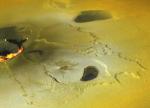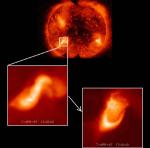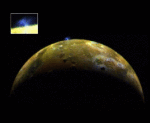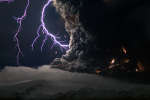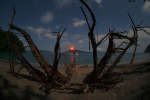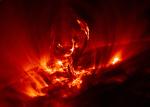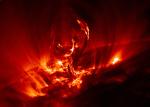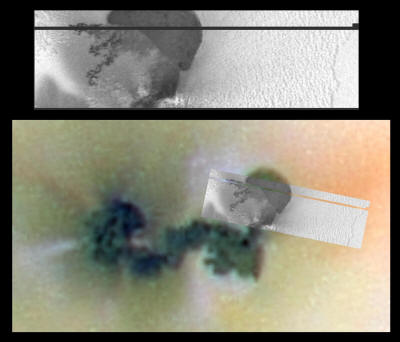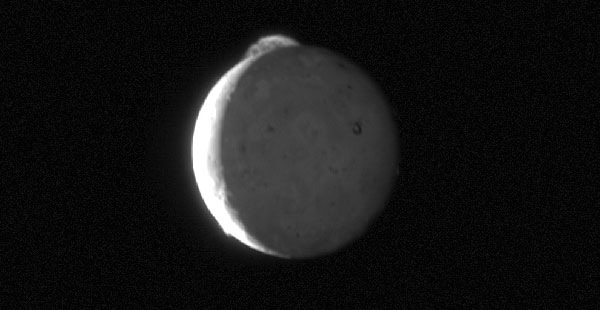

Astronomers Discover Beginnings of 'Mini' Solar System February 07, 2005 Moons circle planets, and planets circle stars. Now, astronomers have learned that planets may also circle celestial bodies almost as small as planets. NASA's Spitzer Space Telescope has spotted a dusty disc of planet-building material around an extraordinarily low-mass brown dwarf, or "failed star." The brown dwarf, called OTS 44, is only 15 times the mass of Jupiter. Previously, the smallest brown dwarf known to host a planet-forming disc was 25 to 30 times more massive than Jupiter. The finding will ultimately help astronomers better understand how and where planets - including rocky ones resembling our own - form.
"There may be a host of miniature solar systems out there, in which planets orbit brown dwarfs," said Dr. Kevin Luhman, lead author of the new study from the Harvard-Smithsonian Center for Astrophysics, Cambridge, Mass. "This leads to all sorts of new questions, like 'Could life exist on such planets?' or 'What do you call a planet circling a planet-sized body? A moon or a planet? '" Brown dwarfs are something of misfits in the astronomy world. These cool orbs of gas have been called both failed stars and super planets. Like planets, they lack the mass to ignite and produce starlight. Like stars, they are often found alone in space, with no parent body to orbit. "In this case, we are seeing the ingredients for planets around a brown dwarf near the dividing line between planets and stars. This raises the tantalizing possibility of planet formation around objects that themselves have planetary masses," said Dr. Giovanni Fazio, an astronomer at the Harvard Smithsonian Center for Astrophysics and a co-author of the new study.
The results were presented today at the Planet Formation and Detection meeting at the Aspen Center for Physics, Aspen, Colo., and will be published in the Feb. 10th issue of The Astrophysical Journal Letters. Planet-forming, or protoplanetary, discs are the precursors to planets. Astronomers speculate that the disc circling OTS 44 has enough mass to make a small gas giant planet and a few Earth-sized, rocky ones. This begs the question: Could a habitable planet like Earth sustain life around a brown dwarf? "If life did exist in this system, it would have to constantly adjust to the dwindling temperatures of a brown dwarf," said Luhman. "For liquid water to be present, the planet would have to be much closer to the brown dwarf than Earth is to our Sun." Formation of Brown Dwarfs Evolution of a brown dwarf begins with its formation in a fragment of a giant molecular cloud with a radius of about 1013 centimeters (or 10-5 light-years). Within the first one million years the cloud fragment condenses into a brown dwarf with an accretion disk (with a radius about 25x109 centimeters) and a peak temperature of about 2,600 degrees Kelvin. In some instances, a planet may form in orbit around the brown dwarf from the material in the accretion disk. After a few million years, the brown dwarf begins a long cooling period as it slowly radiates its heat to space. During the following 10,000 million years the brown dwarf becomes progressively more compact and cooler. Astronomers can get a general estimate of a brown dwarf's age by its temperature and its mass. What are brown dwarfs? Collapsing `stars' with total masses below a certain critical level, about one tenth the mass of the Sun, never become hot enough to trigger nuclear reactions. These `failed stars' are known as 'brown dwarfs'. Unlike stars, brown dwarfs have no central energy source to maintain their luminosity; the only energy available is the heat stored during the collapse of the parent gas cloud. As that energy is radiated and lost, the brown dwarf gradually cools and fades into oblivion. The rate of cooling is mass dependent a brown dwarf just below the hydrogen-burning limit can take 10 billion years to reach 10-6L(sun) a brown dwarf of 0.01 M(sun) (10 Jupiter masses) takes only 107 years to reach the same limit. Very low-mass stars, brown dwarfs and gas-giant planets are almost identical in size. This is due to a property known as degeneracy: the atoms and molecules are as closely packed as possible, so `less stuff' doesn't mean smaller. Lithium: Lithium is generally present in brown dwarfs and not in low-mass stars. Stars, which achieve the high temperature necessary for fusing hydrogen, rapidly deplete their lithium. This occurs by a collision of Lithium-7 and a proton producing two Helium-4 nuclei. The temperature necessary for this reaction is just below the temperature necessary for hydrogen fusion. Convection in low-mass stars ensures that lithium in the whole volume of the star is depleted. SS: my current theories suggest that Jupiter and all the outer planets may not actually have originated in our solar system but actually was it's own brown dwarf system that wandered into this solar system and was involved in massive celestial cataclysmic event that caused the brown dwarf system to rip itself apart like gases being separated in a science experiment in which two gases drop to the bottom and a third gas floats to the top in a glass of water ..
SS: brown dwarfs retain heat as long as they can stay molten and they can stay molten as long as they are inside an accretion disc but as soon as they are not inside an accretion disc they cool and develop a solid core like Jupiter. they seem to act as a battery since once removed from one accretion disc they start to lose their charge as they cool .
SS: my theory suggests that mars was actually orbiting the brown dwarf which sustained it and it's life forms through the heat that radiate from the brown dwarf like how deep marine life are sustained underwater not by the sun but by the heat of the earth .. mars was also internally heated like Jupiter's moon Io the gravitational and magnetic field effects heat mars core causing the core to be molten volcanism .. here is some research data regarding Io's internal heating by Jupiter:
Volcanic Plumes Seen on Jupiter Moon PASADENA, Calif. (AP) - Twin volcanic plumes that rise 250 miles above the surface of Jupiter's fiery moon Io appear in images taken by two NASA (news - web sites) spacecraft and released Thursday. Scientists have known about one of the towering plumes for the past four years. It has continued to spew gas and dust from a volcano called Pele each time the Galileo probe has flown past Io. But when Galileo was joined at Jupiter this winter by the spacecraft Cassini, the two probes caught a second plume. Peering at Io in ultraviolet wavelengths on Jan. 1 and 2, Cassini spied the new plume near the moon's north pole. The discovery was the first of an active plume in that region and the first to rival Pele's plume in size. Images taken days earlier by Galileo but transmitted to Earth earlier this month show a red ring circling a volcanic area called Tvashtar Catena. Scientists said the new ring of deposits makes Tvashtar the likely source of the new plume. "Io is the most volcanically active body in the solar system. Because it orbits so close to giant Jupiter, the planet's gravitational tug constantly flexes the moon like a metal bar bent back and forth. That dynamic causes the moon's extreme volcanism."
Additional:
"This volcanic activity does not erupt lava but liquid sulphur which solidifies to form the red , orange, and yellow of IO's surface. What keeps IO molten is the powerful electrical currents that flow through IO as it orbits within Jupiter's magnetic field, heating the moon like an electric bar fire. IO recycles it's interior onto the surface, endlessly turning itself inside out."
Universe Guide to Star and Planets by Ian Ridpath - Wil Trion
Largest Volcanic Eruption in the Solar System November 14 2002 Astronomers have detected an eruption on Io, a moon of Jupiter, that they say is the largest ever seen in the entire solar system. "It is clear that this eruption is the most energetic ever seen, both on Io and on Earth," said Franck Marchis of the University of California at Berkeley. The eruption was spotted with from the Keck II telescope in Hawaii, using its adaptive optics system, which corrects for the blurring effects of Earth's atmosphere. A white region - the eruption -- was photographed in February 2001 but the data was only recently analyzed by Marchis and colleagues. They released it yesterday.The scientists produced a graphic comparison showing that the eruption on Io was 6,500 times larger than one on Sicily's Mt. Etna. The 1992 Etna eruption was recorded by a Landsat satellite. Exceptionally bright eruption on Jupiter's moon Io November 14, 2002 Routine monitoring of volcanic activity on Jupiter's moon Io, now possible through advanced adaptive optics on the Keck II telescope in Hawaii, has turned up the largest eruption to date on Io's surface or in the solar system. "This eruption is truly massive," said Ashley Davies, PhD, a scientist at NASA's Jet Propulsion Laboratory who aided in modeling the eruption. "The observed energy indicates the presence of a vigorous, high-temperature volcanic eruption. The kind of eruption to produce this thermal signature has incandescent fire fountains of molten lava which are kilometers high, propelled at great speed out of the ground by expanding gases, accompanied by extensive lava flows on the surface." Photo: Observations of Io using the Keck AO system in February 2001. Data are obtained at three different wavelengths from 1 to 2.5 microns. The last column is a view of Io as seen at the time of the observations and based on a map derived from Galileo data. In the images obtained on February 20 little volcanic activity is seen. Two days later however, (bottom row), an extraordinarily bright eruption is in progress in the vicinity of Surt.
SS: this theory regarding the Martian brown dwarf system has one main overall theory but within this theory are multiple other theories that attempt to explain different possibilities like for instance our sun was at one time a protostar that did ignite into a star thus blowing away it's accretion disk. There are two periods in which the celestial cataclysm of the mars brown dwarf system occurred. the first would have been in the period in which our sun was in it's protostar accretion disk development stage to become a star. the Martian brown dwarf system may have entered and wandered around inside the accretion disk of our developing sun .. the other period would have been after our sun had ignited into a star .. more on this later .
SS: if the Martian brown dwarf system entered during the accretion development stage then the plasma of the accretion disk might have preserved the brown dwarfs heat for some time which in effect helped to preserve the advanced civilization that inhabited mars .. this race was so advanced they had built a death star satellite from resources they plundered from solar systems of fixed star's planets and asteroids as they wandered ... this death star satellite still orbits Saturn which now belongs to our fixed star system because obviously mars and the brown dwarf are going nowhere anytime soon .. Saturn's Deathstar Moon SS: At this early stage in the development our protostar sun and the local life form was still an infant stage .. at this particular time period the local life forms of this solar system were at the stage known as Atlantis .. what makes this Atlantis period special was that their were not one but two different sentient life forms here interacting .. there was the high tech Martian hive that were referred to as the Annunaki by the local life form which were the spiritual Mayan/Egyptian Atlanteans of earth .. this is the reason that we see signs of high technology with the Mayan/Egyptian Atlanteans where none should have been .. they were interacting with the Annunaki of the Martian brown dwarf system ..
SS: the Annunaki were very high tech they would visit the earth from mars brown dwarf system by spaceships and this is why we see giant encryptions carved on the earth by the ancients that are viewable from the sky ... this is also why the face on mars is looking out into space because the Martians had space travel .. with their high technology the Martians were able to somewhat govern the native locals .. the Martian Annunaki had mining operations on earth as well as mining operations of asteroids which they would pull into orbit mars and the brown dwarf system ..


SS: however .. this perfect situation of Martian Annunaki rule over the local natives and the plundering of resources did not last .. the whole solar system was suddenly hit by a huge cataclysmic event that resulted in the Martian brown dwarf system being ripped apart by a pounding from space debris. This massive event occurred about 3.8 billion and 4 billion years ago .. The massive event that occurred that separated the Martian brown dwarf into four gas giants, a massive cataclysm impact on mars and a cataclysmic event on earth, and the massive pounding of debris into the earth and moon which caused the massive impact craters on the moon, and all solar system bodies was our infant sun protostar IGNITED, a thermonuclear reaction occurred in the core of the infant sun and the result explosion and solar wind blew the accretion disk and space debris out of the inner solar system to what is now the Oort cloud ..
SS: This one event not only caused massive debris to push out to the outer solar system causing massive bombardment .. but the new sun was the one event that caused the planets to begin to expand due to expansion of magma through the interaction of the planetary spheres with the new sun .. hence the earth and planetary spheres began to develop superplumes and the expanding magma in the planets caused them to begin to grow and expand .. the suns solar flares interacting with the planets cause the cores of the planets to heat and thus magma expansion ..
Dwarf planet 'becoming a comet' Wednesday, 17 January 2007, 09:10 GMT  An unusual dwarf planet discovered in the outer Solar System could be en route to becoming the brightest comet ever known. 2003 EL61 is a large, dense, rugby-ball-shaped hunk of rock with a fast rotation rate. Professor Mike Brown has calculated that the object could be due a close encounter with the planet Neptune. If so, Neptune's gravity could catapult it into the inner Solar System as a short-period comet. "If you came back in two million years, EL61 could well be a comet," said Professor Brown, from the California Institute of Technology (Caltech) in Pasadena. "When it becomes a comet, it will be the brightest we will ever see."
An unusual dwarf planet discovered in the outer Solar System could be en route to becoming the brightest comet ever known. 2003 EL61 is a large, dense, rugby-ball-shaped hunk of rock with a fast rotation rate. Professor Mike Brown has calculated that the object could be due a close encounter with the planet Neptune. If so, Neptune's gravity could catapult it into the inner Solar System as a short-period comet. "If you came back in two million years, EL61 could well be a comet," said Professor Brown, from the California Institute of Technology (Caltech) in Pasadena. "When it becomes a comet, it will be the brightest we will ever see." Cosmic oddball: 2003 EL61 is a large object; it is as big as Pluto along its longest dimension. It is one of the largest of a swarm of icy objects that inhabit a region of the outer Solar System known as the Kuiper Belt. But it is extremely unusual: spinning on its axis every four hours, it has developed an elongated shape. 2003 EL61 is apparently composed of rock with just a thin veneer of water-ice covering its surface. Other Kuiper Belt Objects (KBOs) contain much more water-ice. Professor Brown's computer simulations show that the object is on a very unstable orbit and set for a close encounter with Neptune. The eighth planet's gravitational force could either sling the icy rock ball into the inner Solar System as a comet, out into the distant Oort Cloud region, or even into interstellar space. Orbits of Kuiper Belt Objects tend to be very stable, but the region is thought to be a reservoir for short-period comets. Occasionally, some of these objects must get tossed inward to become the fizzing lumps of ice and dust that criss-cross our cosmic neighbourhood.
Shedding surface: Mike Brown and his colleagues have come up with a scenario to explain 2003 EL61's physical characteristics and behaviour. About 4.5 billion years ago, the object that became 2003 EL61 was a ball, half composed of ice and half of rock - like Pluto - and about the same size as Pluto. Some time early in its history, it was smacked, edge on, by another large KBO. This broke off much of 2003 EL61's icy mantle, which coalesced to form several satellites. As expected, the satellites seem to be composed of very pure water-ice. Professor Brown suggested that some of 2003 EL61's mantle may already have made it into the inner Solar System as cometary material. The oblique impact also caused 2003 EL61 to spin rapidly. This rapid rotation elongated 2003 EL61 into the rugby ball shape we see today. "It's a bit like the story of Mercury," Professor Brown explained. "Mercury got hit by a large object early in the Solar System. It left mostly a big iron core, with a little bit of rock on the outside. This is mostly a rock core with a little bit of ice on the outside." Mike Brown outlined details of his work during a plenary lecture at the recent American Astronomical Society meeting in Seattle. Artist's impression: 2003 EL61 is a strange object
Long-Destroyed Fifth Planet May Have Caused Lunar Cataclysm, Researchers Say 18 March 2002 HOUSTON, TEXAS -- Our solar system may have had a fifth terrestrial planet, one that was swallowed up by the Sun. But before it was destroyed, the now missing-in-action world made a mess of things. Space scientists John Chambers and Jack Lissauer of NASA's Ames Research Center hypothesize that along with Mercury, Venus, Earth, and Mars -- the terrestrial, rocky planets -- there was a fifth terrestrial world, likely just outside of Mars's orbit and before the inner asteroid belt. Moreover, Planet V was a troublemaker. The computer modeling findings of Chambers and Lissauer were presented during the 33rd Lunar and Planetary Science Conference, held here March 11-15, and sponsored by NASA and the Lunar and Planetary Institute. It is commonly believed that during the formative years of our solar system, between 3.8 billion and 4 billion years ago, the Moon and Earth took a pounding from space debris. However, there is an on-going debate as to whether or not the bruising impacts tailed off 3.8 billion year ago or if there was a sudden increase - a "spike" -- in the impact rate around 3.9 billion years ago, with quiet periods before and afterwards? This epoch of time is tagged as the "lunar cataclysm" - also a wakeup call on the cosmological clock when the first evidence of life is believed to have appeared on Earth SS: my theory slightly differs from the above nasa article since i do not think that the bombardment event occurred due to a planet being gobbled up by the sun but rather "that during the formative years of our solar system, between 3.8 billion and 4 billion years ago, the Moon and Earth took a pounding from space debris" was caused due to the ignition of our infant protostar into a star which caused the accretion disc to be blown out to where it now resides as the oort cloud
SS: unfortunately the Martian's did not fair well during the prolonged massive bombardment of cometary plasma space debris which resulted in the rogue brown dwarf being impacted and separated into the four gas giants and a cataclysmic mars taking up a permanent orbit around the newly formed sun .. in the above topography of Mars we can see that a massive object collided with Mars forming the large impact crater called Hellas Basin .. there are actually two major impacts as it appears the object split as it entered the martian atmosphere .. the Olympus Mons and Tharsis Mons super volcanoes might actually have formed during this major impact of mars as massive magma erupt to the surface opposite the impact which likely might have been a comet .. the massive canyon of Valles Marineris may also have formed at this time as the major channel of massive magma flowing from the erupting super volcanoes ...
19:28 27 July 2009
SS: this does go along with my theory here that there was a massive bombardment when the protostar exploded becoming our sun .. the moon was bombarded by space debris being pushed out to where it is now the oort cloud .. at the time of the bombardment the earth would still have been in it's pristine cometary form as well rather than a rocky planet .. with interaction from the sun the earth began to heat and then become more solid .. a lot of the oceans could very easily have come from within the earth's own .. we have underground oceans that connect with our ocean's above ground which is more of an indication that the oceans were formed by water coming from inside the earth rather than outside .

Solar Wind Rips Up Martian Atmosphere Nov. 21, 2008: Researchers have found new evidence that the atmosphere of Mars is being stripped away by solar wind. It's not a gently continuous erosion, but rather a ripping process in which chunks of Martian air detach themselves from the planet and tumble into deep space. This surprising mechanism could help solve a longstanding mystery about the Red Planet. "It helps explain why Mars has so little air," says David Brain of UC Berkeley, who presented the findings at the 2008 Huntsville Plasma Workshop on October 27th.
SS: the sun appears to be pulling air from mars at around the same region in the southern hemisphere as location of impact craters ..
Symmetries of volcanic distributions on Mars and Earth and their mantle plume dynamics "The high level of symmetry of Mars’ volcanic distribution may be the result of a focusing of seismic energy from a major impact in the Hellas area that formed the Hellas basin and may have triggered the onset of volcanic activity in the greater Tharsis area."
Impact-induced Martian mantle plumes: Origin of Tharsis "Tharsis could have experienced a large impact early in Martian history (Schultz & Glicken, 1979; Schultz, 1984; Schultz & Frey, 1990). Recent studies suggest that this hypothesis is plausible from a geodynamical point of view (Reese et al., 2002; 2004). Large impacts at the end of planetary formation are a statistically inevitable consequence of accretional dynamics (Wetherill, 1985,1990; Weidenschilling et al., 1997; Chambers & Wetherill, 1998; Agnor et al., 1999) and result in melting beyond the excavation zone producing an intact melt region with radius of the order of several impactor radii (Melosh, 1990; Tonks & Melosh, 1992;1993; Pierazzo et al., 1997)." 
Superplume Concept Applies To Tharsis Area On Mars "Like Africa, Tharsis bulges out relative to its surroundings, Baker noted. Also, Tharsis shows evidence of a long history of tectonic activity, with faults, rifts, valleys, igneous plateaus and other spectacular features that are similar to the expression of Earth's suspected superplumes, Dohm said. "
as the superplume surged upwards and the supervolcanos began to erupt the lava began to flow in the canyon even as the superplume caused the canyon form as mars began to expand in this region .. view canyons carved by lava flows at Laguna de Laja in Chile in the above link ..
STAY TUNED
"There are volcanoes that would sit on top of the state of Arizona and stand 17 miles high. The canyon system would stretch from New York to Los Angeles, really dwarfing the Grand Canyon," Dohm said. "This is the major heat engine of Mars. And it's probably over 3 billion years old."
The biggest canyon in the solar system can be seen by merging hundreds of photos from NASA's Mars Odyssey orbiter. The canyon system on Mars, named Valles Marineris, stretches as far as the distance from California to New York. Steep walls nearly as high as Mount Everest give way to numerous side canyons, possibly carved by water. Growing evidence of water on Mars adds weight to the theory that life once existed and could still exist beneath its surface, said a group of scientists meeting in San Francisco. Photo:/AFP
SS: my theory just slightly from the nasa theory regarding this canyon .. my theory suggests that Valles Marineris was not formed by water but rather by massive lava flows from the three supervolcanos during the cataclysmic event .. when mars was impacted it caused a massive upsurge plume of lava into the tharsis region resulting in .. this plume upsurge caused a quick expansion of mars crust as seen in this video:
"On the basis of these calculations, we venture to propose that the volcanic history of Mars reflects the transformation of a bipolar mantle plume structure into a single megaplume by the process of plume-plume collision acting in concert with the deep Martian phase transitions. This transformation might have overcome the original pattern induced by a major impact forming the Hellas basin." -- JOURNAL OF GEOPHYSICAL RESEARCH, VOL. 103, NO. E12, PAGES 28,587–28,598, 1998
Billions of years ago, Mars had a lot more air than it does today. (Note: Martian "air" is primarily carbon dioxide, not the nitrogen-oxygen mix we breathe on Earth.) Ancient martian lake-beds and river channels tell the tale of a planet covered by abundant water and wrapped in an atmosphere thick enough to prevent that water from evaporating into space. Some researchers believe the atmosphere of Mars was once as thick as Earth's. Today, however, all those lakes and rivers are dry and the atmospheric pressure on Mars is only 1% that of Earth at sea-level. A cup of water placed almost anywhere on the Martian surface would quickly and violently boil away—a result of the super-low air pressure.
So where did the air go? Researchers entertain several possibilities: An asteroid hitting Mars long ago might have blown away a portion of the planet's atmosphere in a single violent upheaval. Or the loss might have been slow and gradual, the result of billions of years of relentless "sand-blasting" by solar wind particles. Or both mechanisms could be at work.
Brain has uncovered a new possibility--a daily ripping process intermediate between the great cataclysm and slow erosion models. The evidence comes from NASA's now-retired Mars Global Surveyor (MGS) spacecraft.
In 1998, MGS discovered that Mars has a very strange magnetic field. Instead of a global bubble, like Earth's, the Martian field is in the form of magnetic umbrellas that sprout out of the ground and reach beyond the top of Mars' atmosphere. These umbrellas number in the dozens and they cover about 40% of the planet’s surface, mainly in the southern hemisphere.
For years, researchers thought the umbrellas protected the Martian atmosphere, shielding pockets of air beneath them from erosion by the solar wind. Surprisingly, Brain finds that the opposite can be true as well: "The umbrellas are where coherent chunks of air are torn away."
Icy comets – not rocky asteroids – launched a dramatic assault on the Earth and moon around 3.85 billion years ago, a new study of ancient rocks in Greenland suggests. The work suggests much of Earth's water could have been brought to the planet by comets. "We can see craters on the moon's surface with the naked eye, but nobody actually knew what caused them – was it rocks, was it iron, was it ice?" says Uffe Gråe Jørgensen, an astronomer at the Niels Bohr Institute in Copenhagen, Denmark. "It's exciting to find signs that it was actually ice." Evidence suggests that the Earth and moon had both formed around 4.5 billion years ago. But almost all the craters on the moon date to a later period, the "Late Heavy Bombardment" 3.8 to 3.9 billion years ago, when around 100 million billion tonnes of rock or ice crashed onto the lunar surface. The Earth would have been pummelled by debris at the same time, although plate tectonics on our restless planet have since erased the scars. To find out whether asteroids or comets were the main culprits for the bombardment, Jørgensen decided to measure levels of the element iridium in ancient terrestrial rocks. Iridium is rare on the Earth's surface because almost all of it bound to iron and sank into the Earth's core soon after the planet had formed. But iridium is relatively common in comets and meteorites.
Rock or ice
His team calculated the amount of iridium that asteroids would leave on the Earth and moon compared to comets. Because comets have more volatile elements and higher impact speeds due to their more elongated orbits around the sun, they would create giant plumes on impact, allowing more iridium to escape into space than during asteroid impacts. The team predicted that asteroid bombardment would leave iridium levels of 18,000 and 10,000 parts per trillion in rocks on the Earth and moon respectively, while the same figures for comet bombardment would be about 130 and 10. Ancient moon rocks returned by NASA's Apollo missions have already confirmed that the lunar iridium levels are 10 parts per trillion or less. To find out the terrestrial value, Jørgensen's team sampled some of the world's oldest rocks from Greenland, aged 3.8 billion years, and asked a Japanese laboratory to assess their iridium levels more accurately than ever before. They contained iridium levels of 150 parts per trillion. That strongly suggests comets, rather than asteroids, caused the violent bombardment.
Submitted on 23 Jul 2009)
Abstract: The Late Heavy Bombardment (LHB) period is the narrow time interval between 3.8 and 3.9 Gyr ago, where the bulk of the craters we see on the Moon formed. Even more craters formed on the Earth.
During a field expedition to the 3.8 Gyr old Isua greenstone belt in Greenland, we sampled three types of metasedimentary rocks, that contain direct traces of the LHB impactors by a seven times enrichment (150 ppt) in iridium compared to present day ocean crust (20 ppt).
We show that this enrichment is in agreement with the lunar cratering rate, providing the impactors were comets, but not if they were asteroids. Our study is a first direct indication of the nature of the LHB impactors, and the first to find an agreement between the LHB lunar cratering rate and the Earth's early geochemical record (and the corresponding lunar record).
The LHB comets that delivered the iridium we see at Isua will at the same time have delivered the equivalent of a km deep ocean, and we explain why one should expect a cometary ocean to become roughly the size of the Earth's present-day ocean, not only in terms of depth but also in terms of the surface area it covers.
 Fig.1. The volcanic eruption of Etna explained by a whirlwind emanating from the underground, according to Comte A. de Bylandt-Palstercamp (1836): "Théorie des volcans". This reconstruction was based by observations of ancient scholars and myths, especially the faith that earth is formed by the interactions of the four elements: water, earth, fire and air.
Fig.1. The volcanic eruption of Etna explained by a whirlwind emanating from the underground, according to Comte A. de Bylandt-Palstercamp (1836): "Théorie des volcans". This reconstruction was based by observations of ancient scholars and myths, especially the faith that earth is formed by the interactions of the four elements: water, earth, fire and air. Fig.2. View of Mount Etna from Hamilton´s "Campi Phlegraei, Observations on the Volcanoes of the Two Sicilies"; Plate 36, Mt. Etna (1776), based on a painting by Pietro Fabris (an artist hired by Hamilton to illustrate his research); the volcano was quiescent when they visited Sicily in 1769. The lower slopes of the mountain are dotted with minor cones, the prominent double cone of Monti Rossi (on the left) had been formed during the great eruption of 1669, together with a huge lava flow (visible behind the buildings) that had threatened to engulf the city of Catania.
Fig.2. View of Mount Etna from Hamilton´s "Campi Phlegraei, Observations on the Volcanoes of the Two Sicilies"; Plate 36, Mt. Etna (1776), based on a painting by Pietro Fabris (an artist hired by Hamilton to illustrate his research); the volcano was quiescent when they visited Sicily in 1769. The lower slopes of the mountain are dotted with minor cones, the prominent double cone of Monti Rossi (on the left) had been formed during the great eruption of 1669, together with a huge lava flow (visible behind the buildings) that had threatened to engulf the city of Catania.  Fig.3. Topographic map of Mount Etna in 1823 (reprinted in 1844 by Leonhard "Vulkan Atlas") by Mario Gemmellaro, displaying lava flows, cones and villages in the surroundings of the volcano.
Fig.3. Topographic map of Mount Etna in 1823 (reprinted in 1844 by Leonhard "Vulkan Atlas") by Mario Gemmellaro, displaying lava flows, cones and villages in the surroundings of the volcano.  Fig.1. The volcanic eruption of Etna explained by a whirlwind emanating from the underground, according to Comte A. de Bylandt-Palstercamp (1836): "Théorie des volcans". This reconstruction was based by observations of ancient scholars and myths, especially the faith that earth is formed by the interactions of the four elements: water, earth, fire and air.
Fig.1. The volcanic eruption of Etna explained by a whirlwind emanating from the underground, according to Comte A. de Bylandt-Palstercamp (1836): "Théorie des volcans". This reconstruction was based by observations of ancient scholars and myths, especially the faith that earth is formed by the interactions of the four elements: water, earth, fire and air. Fig.2. View of Mount Etna from Hamilton´s "Campi Phlegraei, Observations on the Volcanoes of the Two Sicilies"; Plate 36, Mt. Etna (1776), based on a painting by Pietro Fabris (an artist hired by Hamilton to illustrate his research); the volcano was quiescent when they visited Sicily in 1769. The lower slopes of the mountain are dotted with minor cones, the prominent double cone of Monti Rossi (on the left) had been formed during the great eruption of 1669, together with a huge lava flow (visible behind the buildings) that had threatened to engulf the city of Catania.
Fig.2. View of Mount Etna from Hamilton´s "Campi Phlegraei, Observations on the Volcanoes of the Two Sicilies"; Plate 36, Mt. Etna (1776), based on a painting by Pietro Fabris (an artist hired by Hamilton to illustrate his research); the volcano was quiescent when they visited Sicily in 1769. The lower slopes of the mountain are dotted with minor cones, the prominent double cone of Monti Rossi (on the left) had been formed during the great eruption of 1669, together with a huge lava flow (visible behind the buildings) that had threatened to engulf the city of Catania.  Fig.3. Topographic map of Mount Etna in 1823 (reprinted in 1844 by Leonhard "Vulkan Atlas") by Mario Gemmellaro, displaying lava flows, cones and villages in the surroundings of the volcano.
Fig.3. Topographic map of Mount Etna in 1823 (reprinted in 1844 by Leonhard "Vulkan Atlas") by Mario Gemmellaro, displaying lava flows, cones and villages in the surroundings of the volcano. 







